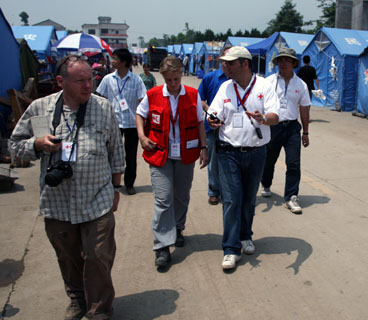By John Sexton

Francis Markus (left), China spokesman for the International Federation of Red Cross and Red Crescent Societies (IFRC), in Deyang Prefecture, where the IFRC plans to provide millions of dollars in reconstruction assistance to rural residents who lost their homes in the May 12 Sichuan earthquake.
The International Federation of Red Cross and Red Crescent Societies (IFRC) plans to spend around a third of its 95 million US dollar Sichuan earthquake appeal to help people in rural areas rebuild their homes IFRC China spokesman Francis Markus told China.org.cn on 16 July.
The bulk of the aid will be targeted towards the most vulnerable sections of the community in Deyang prefecture which was badly hit by the May 12 earthquake. The IFRC is already operating clean water and sanitation projects in Deyang, in and around Jiulong Township, which was virtually leveled by the quake.
Mr. Markus said that people in the quake-hit areas are very focused on rebuilding their lives and homes. After disasters worldwide people as a rule spend between 2 and 3 years living in temporary accommodation, but he expected that in China people will want to make the move back into permanent housing much sooner. Mr. Markus said that everything else in the relief operation had gone at a very fast pace and he expected resettlement into permanent homes to be no exception.
He said that in Jiulong people have demonstrated tremendous resourcefulness and resilience, reopening shops and businesses literally among the ruins, including one woman who has struck a deal with a major publishing house to distribute her traditional Chinese New Year paintings. But, like many areas hit by the quake, Deyang is a tourist destination and many people have sunk their savings into small guesthouses which have all been destroyed.
People are very keen to know how much rebuilding assistance they will receive from the government and other sources. The cost of rebuilding an average rural home in Sichuan is approximately 80,000 yuan (US$11,375) a huge sum for people who have, in many cases, lost everything and for whom obtaining credit will be very difficult.
Mr. Sun Tingyun, head of the Planning Division of Chengdu Municipal Development and Reform Commission told China.org.cn on 17 July that people in rural areas under Chengdu's administration can expect to receive 20,000 yuan in government rebuilding assistance, a figure that may well turn out to be the norm throughout Sichuan. To make up the shortfall many people will have to seek temporary jobs outside Sichuan as the earthquake destroyed many local workplaces and jobs. The IFRC plans to target its aid to help meet the funding gap for those less able to earn the money through their own efforts. Concrete plans for distributing the funds will be worked out in cooperation with the Red Cross Society of China who, in turn, will coordinate their efforts with the government's plan for reconstruction.
The Sichuan provincial government has set a target to place all those made homeless by the quake in prefabricated housing by 1 August. According to Mr. Markus, the authorities are erecting prefabs as fast as possible, but there are still hundreds of thousands of people living in tents around the province, most of them in remote rural areas. Mr. Markus said that as the weather becomes hotter, conditions in the tents are becoming quite harsh. He also said that, as people in Sichuan are progressively moved from tents into prefabs, the IFRC has begun transferring tents from Sichuan to areas of Gansu and Shaanxi provinces that were also hit by the May 12 earthquake.
(China.org.cn July 19, 2008)